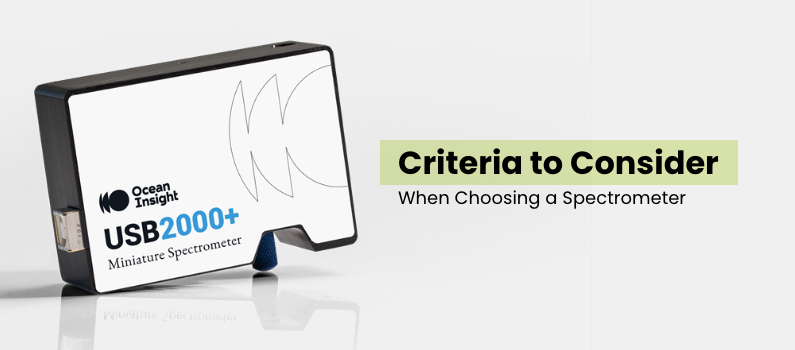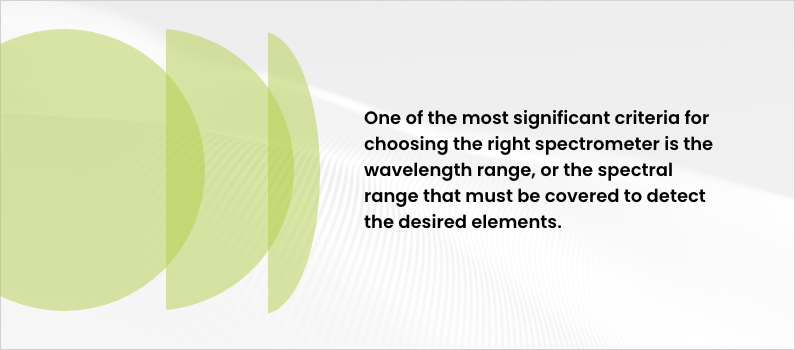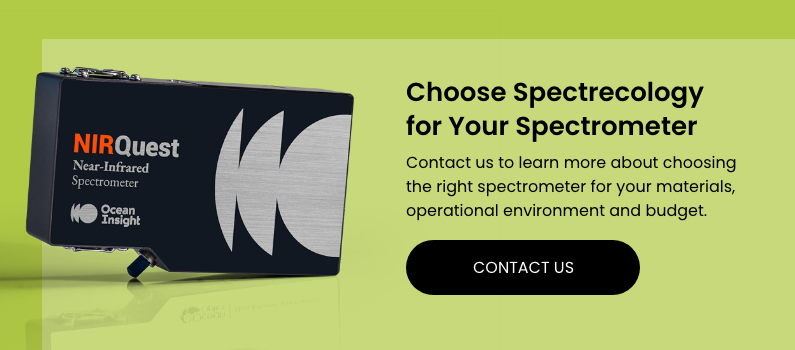A spectrometer can measure light intensity over the electromagnetic spectrum, with different spectrometers covering ultraviolet (UV), visible (VIS), infrared (IR) and near-infrared (NIR) ranges. The wide selection of available spectrometers provides many measuring options for application in commercial, industrial and educational sectors. Various industries have adopted spectrometers for lab, field and process solutions due to their low-cost, versatility, portability and measurement speed.
There is no one-size-fits-all instrument when it comes to this technology, so it’s essential to choose the right spectrometer for your application of spectroscopy.
A Spectrometer for Any Application
When selecting a spectrometer for your lab, it may help to consider the different spectrometers by application. Then, assess whether a particular model meets the necessary criteria.
This quick overview reveals some of the most common spectrometers for various applications:
- UV-visible spectrometers: By employing two lamps, tungsten and deuterium, a UV-VIS spectrometer can measure both ultraviolet and visible wavelengths from 190 nm to 1100 nm. This technology helps characterize and identify organic molecules by providing highly accurate analysis of low-complexity gas or liquid samples. UV-visible spectrometry has applications in quality control for the chemical, pharmaceutical and food processing industries.
- General-purpose spectrometers: Multi-application OEM spectrometers are capable of providing the measuring options needed for many diverse use cases. Spectrecology’s general-purpose spectrometers offer the versatility, measurement speed and modular design required for the application of spectroscopy in various industries, such as medicine, security, biology and metallurgy.
- High-performance spectrometers: Enhanced optical resolution is one of the main advantages of high-performance spectrometers over general-purpose models. High-performance optical spectrometers also have a wider dynamic range, higher sensitivity, faster data acquisition and improved quantum efficiency. This technology is suitable for many applications in industrial and research sectors due to its high dynamic range.
- Near-infrared spectrometers: An NIR spectrometer offers accurate, noninvasive measurements, allowing users to quickly determine the chemical composition of a wide range of materials. Minimal sample preparation is required, making NIR spectrometry ideal for measuring fat, fiber, protein, starch and moisture content. In addition to determining a sample’s chemical and physical properties, NIR spectrometers have applications in quality control for the biomedical, chemical, agricultural, pharmaceutical and food processing industries.
- Raman spectrometers: Raman models use diffusion spectrometry to perform detailed chemical structure analysis of various substances. Analyzing a sample will quickly reveal any contamination and compounds present for production processes and quality control. Raman spectrometers help identify dangerous or banned materials in applications across various industries, including life sciences, cosmetics and pharmaceuticals. Raman models are also suited for rugged applications outside the lab, like archeology.
With the spectrometer’s application in mind, your final choice will depend on factors like the overall size, detection limits, wavelength range, cost and measurement time. Custom or preconfigured method options may also make choosing a spectrometer more challenging.
Below, you can find some criteria for choosing the right spectrometer. Our guide may help you determine which spectrometer parameters you should focus on for your application.
Criteria 1: Density, Shape and Size of the Sample
Before deciding on a suitable spectrometer, consider the minimum sample size needed for molecular analysis and the maximum sample size the machine can accommodate. Depending on the density, shape and size of the product you wish to measure, your samples may be better suited to a particular type of spectrometer.
The size of the machine can also be crucial, as you will need adequate space to use and store it. For example, if you need a compact spectrometer, features to look for include a small detector size, high grating dispersion and low numerical aperture. Spectrometers can be used in many different settings for diverse applications, so choosing one that suits your materials and operational environment is necessary.
Criteria 2: Detection Limits
Consider the detection limits achievable for individual elements to determine how practical a spectrometer is for your analytical problem. Evaluate whether the spectrometer’s detection limits meet your specific research goals. Depending on these goals, you may also need to choose between models that distinguish different wavelengths. Visible light spectrometers, UV-VIS spectrometers and near-infrared spectrometers can each detect very different wavelength ranges.
Criteria 3: Wavelength Range
One of the most significant criteria for choosing the right spectrometer is the wavelength range, or the spectral range that must be covered to detect the desired elements.
To determine the wavelength range needed for your goals, you must look at the measured product’s spectroscopic characteristics. For example, if you need to analyze the color of a sample, you want a spectrometer that covers the visible spectrum from 360 and 740 nm. UV-VIS spectrometers measure wavelengths from 190 nm to 1100 nm, ensuring that you can identify most colored materials with ultraviolet or visible light.
In some cases, the material under study will emit light that can be dispersed as a function of wavelength through a spectrometer. The light being emitted will fall onto the detector, allowing you to detect the wavelength range. Many types of spectrometers also feature a light source to generate an optical signal of known frequencies. Test the absorption of transmissive material at different wavelengths to detect its range.
The wavelength range will reveal a sample’s chemical composition and whether light is emitted or absorbed by a material. Wavelength ranges define the appropriate grating choice for a spectrometer. Since the grating is often responsible for dispersing the light, it is recommended to use a grating of 300 lines/mm for wide wavelength ranges. Meanwhile, smaller ranges of about 500 nm with higher resolution might benefit from a grating of 600 lines/mm.
Criteria 4: Cost
Total cost is an essential factor. Consider the instrument’s price and any associated consumables. The anticipated price of a spectrometer often corresponds with your purchasing choices for other parameters like detection limits, wavelength range and measurement time. Its actual footprint and data export options may also impact the expense.
If you need a low-cost system, consider models with low resolution and smaller sizes. Instruments offering only basic features are generally less expensive. Contrarily, more versatile systems and models offering greater automation tend to have a higher price.
Criteria 5: Measurement Time
The final selection of a spectrometer may come down to its measurement time. However, whether you need to prioritize this parameter or not often depends on the operational environment. Generally, data-acquisition rates are less demanding in a research laboratory, allowing educational sectors to focus on other criteria like detection limits and data quality instead. In contrast, the time required for material analysis can be crucial in production industries, where higher speed means greater efficiency on the factory floor.
A spectrometer with a fast measurement time is helpful for applications in security and authenticity, biomedical sciences and the food and agricultural industries. High-speed spectrometers fulfill requirements for high-speed data acquisition, robust communication protocols and onboard processing. If you require a high-speed spectrometer, look for instruments with a transmission grating and high sample throughput. By maximizing the number of samples that can be analyzed per unit of time, you will increase production efficiency.
Criteria 6: Custom or Preconfigured Method Options
Selecting a spectrometer is a reasonably specific but straightforward process, dependent on your unique application. Consider whether the system has customizable or preconfigured testing method capabilities. The operational environment may benefit from both options, especially for consecutive sample analyses and measurement time.
Choose Spectrecology for Your Spectrometer
At Spectrecololgy, we offer a range of spectrometers that can meet various industrial, educational and commercial needs. Our spectrometry products are portable, high-performance, cost-effective and user-friendly, and we offer free technical support on all purchases. We want to help you create the perfect system based on your goals. Contact us to learn more about choosing the right spectrometer for your materials, operational environment and budget.




